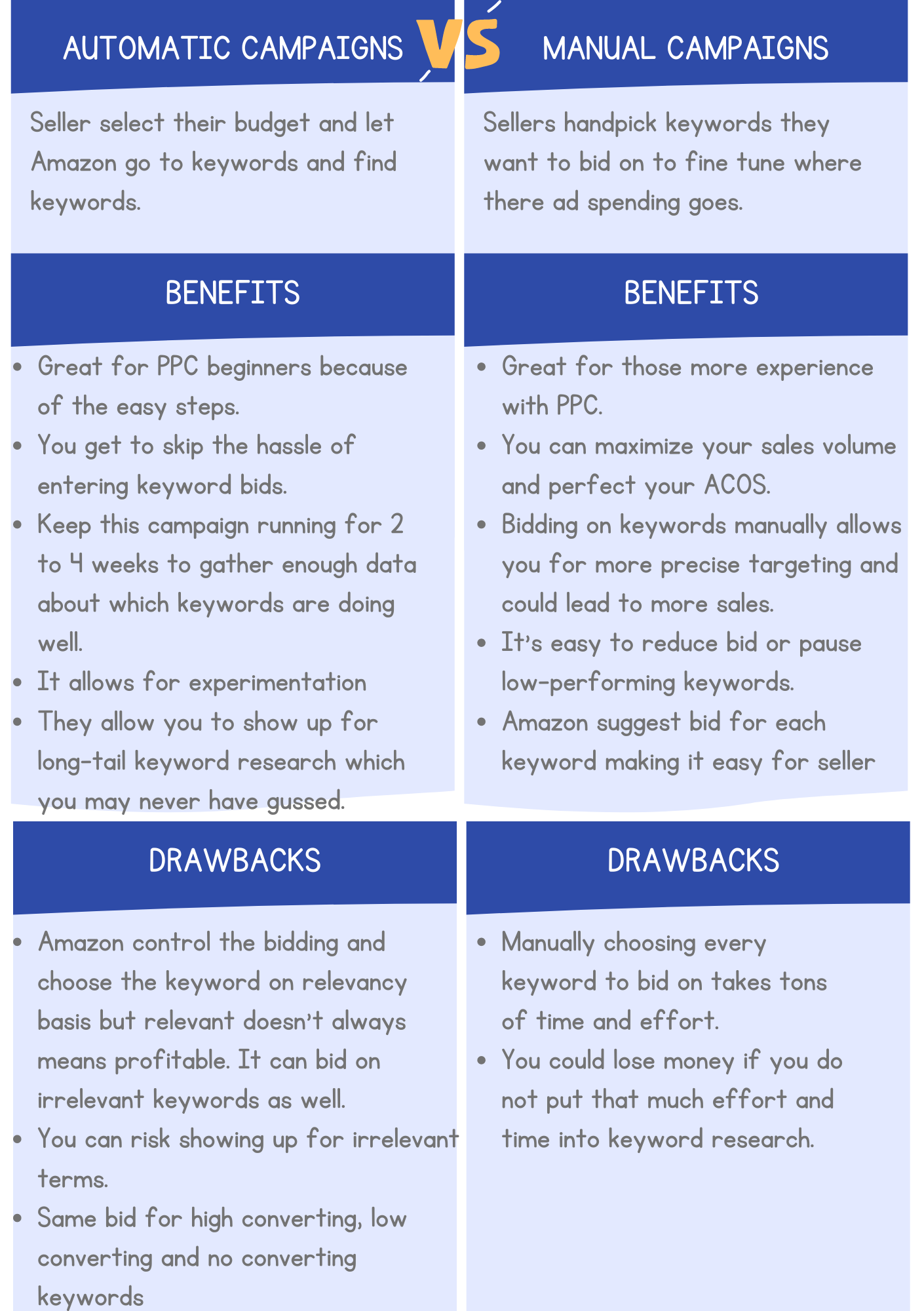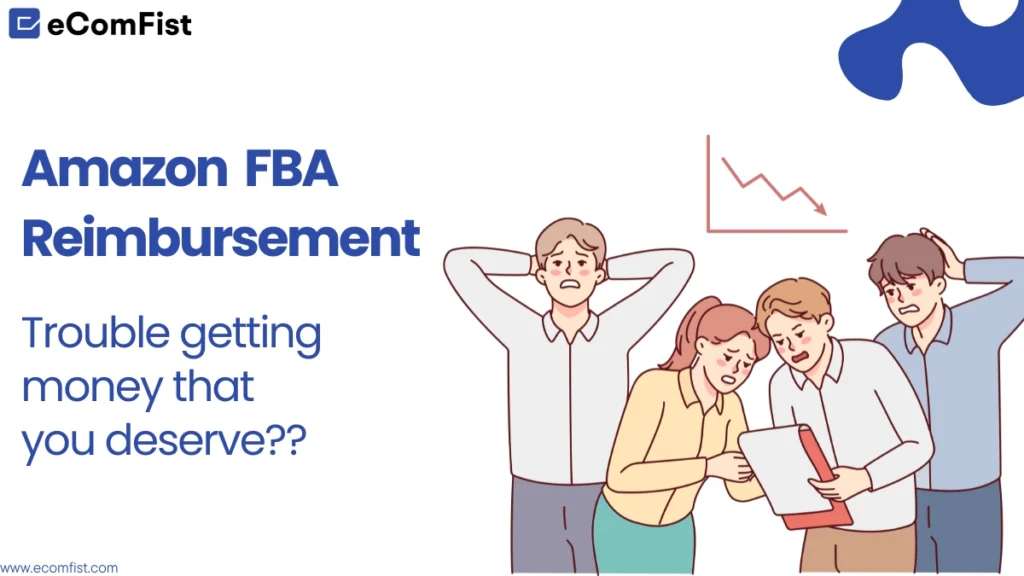With time, more and more sellers are realizing the potential of Amazon’s PPC advertising campaigns, but the top performers are usually those that have the most agile and efficient Amazon PPC strategy. What is the ideal pay-per-click (PPC) strategy for Amazon sellers? This is a hot topic in the marketplace at the moment. Which kinds—sponsored products, sponsored brands, or display ads—as well as how to run each one – manually or automatically?
Amazon advertising is expected to see the following major trends in 2024, all of which we have already gone through.
- Top sponsored product ad placement hack in 2023
- 05 must-see 2023 trends for Amazon brand ads that you can’t miss
- 07 best Amazon marketing trends and predictions every seller should know
Let’s dig deeper into the debate between automatic vs. manual campaigns.
How does Amazon’s PPC work?
For sellers to promote their products on the Amazon marketplace, Pay-Per-Click (PPC) advertising is an excellent choice. Using PPC campaigns, businesses can compete for customers’ attention by bidding on keywords related to their products. It’s sort of like having a shop window that never closes and brings in people around the clock.
Amazon provides both automatic and manual PPC marketing. Amazon takes the wheel and drives automatic campaigns, while sellers are in charge of manual campaigns. The idea is the same for automatic and manual cars. Both forms of advertising campaigns have their benefits and drawbacks, and the choice between them should be made in light of the seller’s advertising objectives and budget.
In the following sections, we’ll examine automatic and manual campaigns in further detail and talk about the components that can help sellers choose between the two. We will also share some tips for improving your Amazon PPC campaign’s performance in order to boost brand awareness and revenue.
What are automatic campaigns?
Amazon’s algorithm creates and oversees automatic PPC ads. Amazon’s incredibly sophisticated algorithm selects keywords and ad placements for automatic campaigns once sellers select a target product or product category.
Starting off with PPC advertising on Amazon might be challenging, but automatic campaigns remove much of the legwork. However, poor targeting and bidding strategies can lead to a low return on investment (ROI) and a high advertising cost-per-acquisition (ACOS).
Pros and Cons of Automatic PPC Campaigns
Pros of Automatic Campaigns
- It’s quick to set up and control, and you don’t need a rocket scientist to launch your ad campaign.
- It gives extensive exposure as a result of Amazon’s algorithm’s focus on various keywords and ad placements (similar to talking to the stars about your advertising).
- It allows you to find successful and profitable keywords for use in manual campaigns.
Cons of Automatic Campaigns
- Targeting and bidding strategies are outside of your control. You are not the boss in this case.
- Cause high advertising costs and low conversion rates. That’s why, sometimes, it’s like paying for a five-star meal and receiving a microwave supper.
- There is no way to tell which keywords and where they appear are actually generating revenue. No doubt, you will miss this pleasure.
What are manual campaigns?
In PPC advertising, “manual campaigns” are those that the seller themselves creates and oversees. When running a manual campaign, the seller decides who to target and how much to bid. Advertisers have complete control over their campaigns, down to the individual keywords, match types, bids, and ad cycles.
So, you can say manual campaigns are like do-it-yourself Amazon PPC. It’s like building your own house with your bare hands instead of paying someone to do it for you. All the decisions, guidelines, and blueprints are up to you! Manual campaigns involve more time and knowledge on the part of the seller, but they have the potential to generate more revenue and make better use of advertising funds.
Pros and Cons of Manual PPC Campaigns
Pros of Manual Campaigns
- Totally controllable targeting and bidding processes. So, you think of yourself as a boss here.
- Capacity to optimize campaigns for higher efficiency and lower costs. It seems like more bang for the buck.
- Better understanding of specific keywords and elements that are driving sales.
Cons of Manual Campaigns
- Campaign setup and management require more time, energy, and expertise. Being an expert marketer is like being a wizard; you have to know what you’re doing.
- Like a pet that requires continual care and attention, it may need constant monitoring and optimization to keep running at peak efficiency.
- Reach could be reduced if either the targeting or the bidding is overly specific. If you organize a party and invite three individuals, you shouldn’t expect much of a good time.
How to Decide Between Automatic and Manual Campaigns?
Sellers should think about their advertising objectives, budget, and competence level when choosing between automatic and manual campaigns. However, the best results are achieved when both campaigns are utilized. Keep in mind that you can’t get the desired outcome from running only one kind of campaign. Because the most effective strategy is:
- First, make use of the automated campaigns that can help you find the most profitable keywords.
- Then, based on the best-performing keywords, you may optimize the manual campaigns.
If you’re a seller with either a low advertising budget or no experience with Amazon PPC, consider using an automatic campaign. But here’s a deal. Up-front optimization of your product listings is key. Amazon’s automatic PPC campaigns are always handled on the basis of the keywords you provide within the product listings, so if you can’t do it correctly with the right keywords, your automatic campaigns and product listings will be bogged down. This is also one of the major failure of 95% amazon sellers.
Best practices for leveraging automatic and manual campaigns
Here are some best practices on how to use both automatic and manual strategies in Amazon PPC advertising:
Stage 1: Setting Up Automatic Campaigns
Start with automatic campaigns
Start with an automatic campaign to gather information about important keywords, placements, and search terms that can be used to improve your manual campaign later.
Set an appropriate budget
Determine a daily budget that works for your product, and make adjustments as needed depending on metrics.
Monitor search term reports
Consistently examining your search term records will help you find successful and profitable keywords, negative keywords, and high-performing keywords.
Extract the best keywords
Give the campaign at least two weeks to run. Then, based on the data (impressions, clicks, CPC, ACOS, and conversions), pull out the best keywords to utilize in your manual campaigns.
Stage 2: Setting Up Manual Campaigns
Use the data from the automatic campaign
Create an additional manual campaign that uses the data gathered from the automatic one to zero in on the most effective keywords and placements. It’s best to use only 30 keywords and get as close as possible to 100, but not more than this.
Choose product-related keywords
Use product-related keywords with a high search volume and a low cost per click (CPC). Don’t use generic keywords in your campaign.
Choose the specific match type
When running a manual ad campaign for the first time, broad match is the best option. By offering to the largest possible range of customer queries, you may significantly increase your chances of success. But you can also limit your match types to “phrase” or “exact” to reach more specific keyword searches.
Bid a little higher
Bid a little more on the keywords you want to focus on in the manual targeting campaign than you would in the automatic campaign to assist boost sales. You can gradually raise your prices on the most profitable keywords.
Extract keyword list
Download the “Search Term” report from the “Advertising reports” tab after the campaign period has ended, just as you did with the automatic campaign. For the next round of the campaign, use the data gathered under “Impressions,” “Clicks,” average “Cost Per Click” (CPC), and/or advertising cost of sale (ACOS) to generate a list of high-performing keywords.
Optimize your bidding strategy
Using the campaign’s performance data, set bids for each high-performing keyword that are both realistic and competitive for the next cycle of ad.
Stage 03: Managing the Campaign in Progress
Track the success of your campaign
You need to keep an eye on the stats for both your automatic and manual campaigns to see where you can make changes for the better.
Adjust your bids
Keep adjusting your bids to be competitive in the auction and get the most value for your money.
Improve your keyword strategy in an ongoing manner
Adjust your keyword strategy, including the addition of negative keywords and the removal of under-performing keywords, based on the results of your automatic and manual campaigns.
You may enhance your exposure, click-through rate, and sales on the Amazon marketplace by following these best practices and using a combination of automatic and manual campaigns in your Amazon PPC advertising.
These practices are generic. Always keep in mind that rules are always based on circumstances. How?
Read what my experience says….
This is how eComFist strategically uses both campaigns.
In simple terms, playing around with keywords is the whole point of running PPC ads. In advertising, it is encouraged that Amazon sellers target keywords with both a low level of competition and a high level of search volume. However, we use a variety of approaches, depending on the type of product listing.
To begin, I always recommend using keywords with low search volume and low competition for those who have recently launched the product. This strategy should be maintained until the product listings receive positive reviews. For the simple reason that high-volume search terms attract higher bids, and the seller has already invested heavily in the launching phase. Plus, customers have more faith in product listings that have received positive reviews. So, it’s expensive and pointless to start with high-volume terms. However, sometimes it works, but with high capital. Don’t take it personally)
There are times when low-search-volume keywords do better than high-search-volume keywords. (It happens more than I think.)
When low-volume keywords start doing well and getting good reviews, we prefer to bid on high-performing keywords. My strategies have a 100% success rate.
This is just one way I showed how keywords can be used in both automatic and manual campaigns. I could also choose the other scenario, just to play with keywords and see the success of campaigns. That’s right, because rules are always based on the circumstances.
By now, you should understand the importance of hiring an Amazon marketing agency or utilizing Amazon advertising services. But if you’re still not sure, don’t be afraid to get in touch with us for a free consultation. We would be happy to provide further explanation and assistance.
Final Thought
In conclusion, the secret to successful Amazon PPC advertising is being on top of the game and optimizing your campaigns, whether you’re using automatic, manual, or a hybrid of the two. When it comes to advertising on Amazon, the old adage “you snooze, you lose” couldn’t be more appropriate. Don’t be afraid to switch things up, test out new tactics, and maintain a high level of vigilance when managing your campaign. If you’re really good at Amazon marketing, maybe your product will become the next big thing on Amazon.












